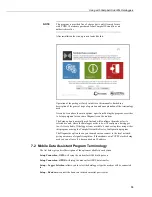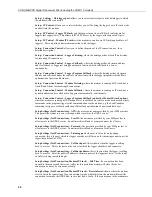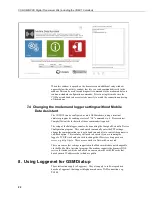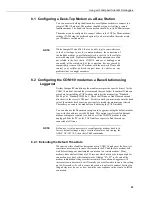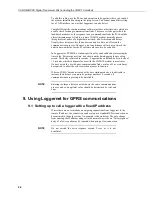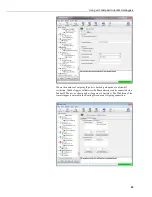
CS-GSM/GPRS Digital Transceiver Kits (including the COM110 modem)
Setup – Settings - Datalogger port:
allows you to select the serial port on the datalogger to which
the modem will be connected.
Setup – IP Control:
allows you to select whether you will be using the logger’s own IP stack or the
one built into the modem.
Setup – IP Control – Logger IP Stack:
sets the logger to run its own IP Stack (only shown for
loggers that support this). This allows full TCP/IP access by the logger, allowing email, ftp etc.
Setup – IP Control – Modem IP Stack:
sets the modem to run its own IP Stack (applicable to all
loggers). This only allows basic communications with the logger.
Setup – Connection Control:
allows you to define the mode of the IP connection (see for a
detailed description)
Setup – Connection Control – Logger Listening:
where the datalogger has a fixed IP and listens
for incoming IP connections.
Setup – Connection Control – Logger Callback:
where the datalogger has a dynamic address
and is calls back to Loggernet using an automatic function which calls-back to a server
continuously.
Setup – Connection Control – Logger Program Callback:
where the datalogger has a dynamic
address and calls-back under the control of instructions within the logger program (which allows
optimisation of power and data use).
Setup – Connection Control – Modem Listening:
where the modem is running its IP stack, has a
fixed IP and listens for incoming IP connections.
Setup – Connection Control – Modem Callback:
where the modem is running its IP stack, has a
dynamic address and is calls back to Loggernet automatically, continuously.
Setup – Connection Control – Logger Program Callback (under the Modem IP stack option):
where the modem is running its IP stack and is set to call-back but only to make a connection where
commands in the program trigger serial communication via the modem, e.g. the SendVariables
command to trigger a call-back collection.(This allows optimisation of power and data use).
Setup Settings (for IP connection) – APN:
the access point name provided by your SIM provider.
This points the system to a server through which is accesses the GPRS service.
Setup Settings (for IP connection) – User ID:
the user name provided by your SIM provider to
allow access to the GPRS service. Sometimes this is blank or a common name for all users.
Setup Settings (for IP connection) – Password:
the password provided by your SIM provider to
allow access to the GPRS service. Sometimes this is blank or a common for all users.
Setup Settings (for IP connection) – Listening port:
when set to listen for an incoming
connection, this is the port which the logger or modem will listen on for incoming connections (the
logger has a default of 6785).
Setup Settings (for IP connection) – Call-back port:
this is shown when the logger is calling
back to a server. This is the port on the server to which the logger should try and connect to.
Setup Settings (for IP connection) – Call-back address:
this is shown when the logger is calling
back to a server. Enter the public IP address or domain name of the loggernet server (or the router
its traffic is being routed through).
Setup Settings (for IP connection, Modem IP Stack ) – Idle Time
: if a connection has been
opened to the modem and there is no traffic for this period the modem will close the socket
connection as it may be erroneous or faulty.
Setup Settings (for IP connection, Modem IP Stack) – Reset interval:
shown where the modem
is set to listen for connections. If no connection is made within this time the modem will reset the
connection to remake the GPRS link, in case that link is faulty. If the connections to the modem are
20














